In this article, we will discuss how to grow the familiar and scented shrub of Lavandula (Lavender) in containers. You may be familiar with the plant but in this article, you will discover how to get the best from your Lavender plants. Lavandula is a modestly sized flowering shrub of 47 species that belong to the Lamiaceae (Mint) family. It is native to Cape Verde, the Canary Islands, Europe, Africa, and Southeast Asia all the way to India.
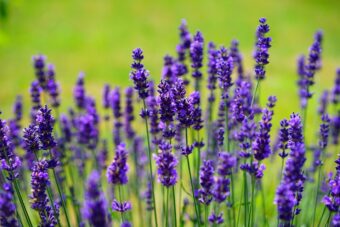
They are often used as Ornamental shrubs in colder climates, where you often see them growing in gardens, but the same plant will do well growing in containers. They can be used as a herb but it also used commercially for the oil it produces. The genus is split into the not often seen annuals or short-lived perennials or the small shrubs that will be described in this article.
THE LEAVES AND THE FLOWERS ARE THE REASONS FOR WHY IT IS GROWN
It is grown for its greyish-green leaves which are often simple in some species. In others, the leaves are pinnately toothed and may be dissected. The leaves of most species are covered with fine hairs, where all the essential oils are kept. If there is one plant that because of its miniature size should be grown in containers, then this is the plant for you. The leaves are also aromatic and so are the flowers that are borne in whorls heads on spikes. The spikes are borne above the leaves and make a great addition to potpourri, where the scent can be enjoyed in the home.
The flowers may be blue, violet, purple, pink or white depending on the species and variety grown. The flowers appear from July to September and are usually blue in colour but as said before this does not necessarily be the case. Lavender flowers are very attractive to butterflies and bees. Lavenders you will often find sold by the bucket in shops are either English Lavender (Lavandula angustifolia) or French Lavender (Lavender stoechas).
If you prune them after flowering, you may experience a smaller flush. Nothing special but worthwhile. Find out how to grow the beautiful fragrant shrub of Lavender in containers in this article.
GROWING LAVENDULA IN CONTAINERS
First, choose a container that will suit the plant in question and is well-balanced. It is best to plant Lavender in April or May as the soil will be warming up and fresh plants will become available online and in garden centres. Whatever container you use make sure it has plenty of drainage holes at the bottom. To this container add a 2cm layer of gravel to improve drainage even further. On top of this create a growing media made by mixing 70% by volume of multipurpose compost with 30% by volume of washed building sand.
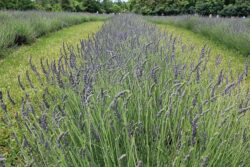
Fill the container to 5cm below the top rim. Free-draining growing media is a must. At this stage, you will not need to feed them as they can grow in poor, dry compost. At the centre of the container make a hole slightly larger than the root ball it came in the original container, Drop the plant in so that the top of the root ball is at the same level as the top surface of the compost in the container.
Backfill with the growing media so that no vacant spaces remain, using more compost if you find it necessary. Firm the plant in and water well.
THE BEST GROWING CONDITIONS
This is one plant that likes the sun so locate your container where it will get the brightest light.
A newly planted lavender will need to be watered regularly during its first growing season, so water as soon as the top surface feels dry to the touch. After the first year, it will take drought pretty well but you will need to water when 5cm below the top surface of the compost feels dry to the touch. In winter when excess rainfall is to be expected then you should place your container in a rain shadow to stop any potential root rot from killing your plant.
As said earlier this is one plant that does not need feeding so do not do so unless your plant is showing obvious nutrient deficiency signs.
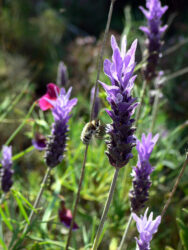
English lavender and its hybrids tend to be hardier and can be left outside in a rain shadow, whilst French lavender is tenderer. They will need to be moved to a sheltered spot, away from harsh winter weather. Tender species will need to be brought in and protected in a greenhouse to overwinter and prevent losses.
To prune you will need to cut off spent bloom as soon as they fade. You can prune back plants in April but do not cut into old wood.
To propagate you can plant semi-ripe cuttings in a cold frame in summer. Allow them to grow on for planting next year.
PESTS AND DISEASES
If you get the growing condition right, they tend to be pests and diseases-free, especially if grown in full sun and with free-draining compost. Heavy soils will lead to root rot and the death of the plant.
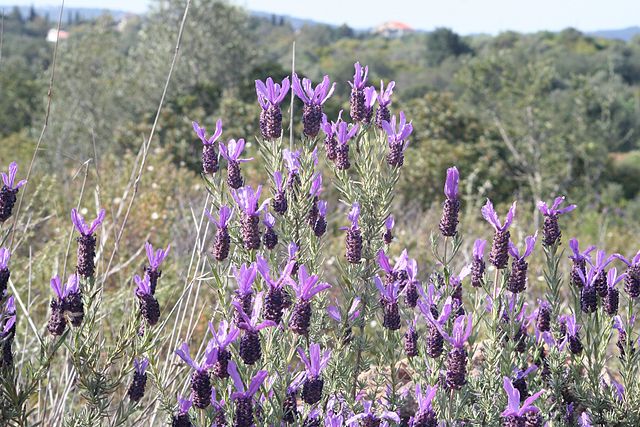
Some Lavenders are not hardy and will not survive outside. These will need to be brought inside a greenhouse. Insects will nibble the leaves but the damage is superficial such as caused by the rosemary beetle. It is best to ignore the damage caused.
VARIETIES TO GROW
The most popular variety is Lavandula angustifolia (the English Lavender) with its grey-green leaves and whorls of tiny flowers. The hardiest of all Lavender varieties include ‘Hidcote’ with Lilac flowers, ‘Hidcote Pink’ (Pink Flowers), ‘Munstead’ (Lavender Blue flowers and green leaves), ‘Imperial Gem’ (Dark purple flowers), ‘Melissa Lilac’ (Lilac and heavily scented) ‘Nana Alba’ (White flowers), ‘Arctic Snow’ (White flowers), ‘Rosea’ (Pink flowers and green leaves). A noted miniature is ‘Mini Blue’.
Lavandula dentata (Fringed Lavender) has fine-toothed green leaves and compact purple flowers with a lighter bract on top. Less aromatic in terms of flowers but more fragrant in terms of leaves.
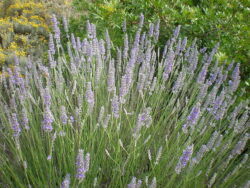
Lavandula stoechas (French Lavender) has unusual bracts of ‘bunny ears’ that emerge from dark purple flower spikes. Flowers are not aromatic but the light green leaves are. Noted varieties include ‘Flaming Purple’, ‘Fathead‘ and ‘Bandera’.
A hybrid between the English and the Portuguese Lavender (Lavandula latifolia) is called Lavandula x intermedia. It produces tall spikes of highly fragrant dark flowers. It is noted as making a great addition to potpourris. Noted varieties are ‘Phenomenal‘, ‘Heavenly Night’ and ‘Heavenly Scented‘.
CONCLUSIONS
In this article, we have discovered how to grow the firm favourite of Lavendula in containers. They are pleasant to look at, release a great scent and easy to look after and are compact, making them a great container plant.
They are great to grow and you should try to grow them. If you have any questions or comments that you wish to make on growing Lavendula in containers, please do so in the comment box below.
Happy Lavendula growing.
